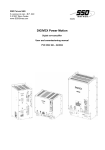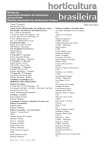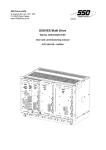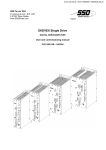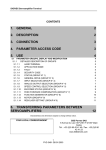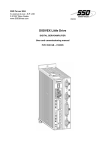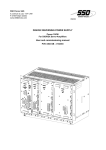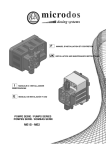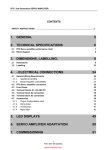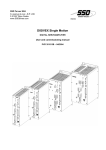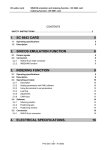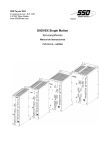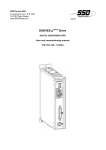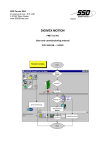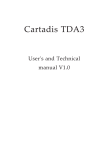Download PVD 3484 GB
Transcript
SSD Parvex SAS
8, avenue du Lac - B.P. 249
F-21007 Dijon Cedex
www.SSDdrives.com
DIGIVEX Power Drive
Digital servoamplifier
User and commissioning manual
PVD 3484 GB – 04/2004
PRODUCT RANGE
1-
« BRUSHLESS » SERVODRIVES
TORQUE OR POWER
RANGES
•
•
•
2-
BRUSHLESS SERVOMOTORS, LOW INERTIA, WITH RESOLVER
Very high torque/inertia ratio (high dynamic performance machinery):
⇒ NX -HX - HXA
⇒ NX - LX
High rotor inertia for better inertia load matching:
⇒ HS - LS
Varied geometrical choice :
⇒ short motors range HS - LS
⇒ or small diameter motors : HD, LD
Voltages to suit different mains supplies :
⇒ 230V
three-phase for «série L - NX»
⇒ 400V, 460V three-phase for «série H - NX»
"DIGIVEX Drive" DIGITAL SERVOAMPLIFIERS
⇒ SINGLE-AXIS
DSD
⇒ COMPACT SINGLE-AXIS
DµD, DLD
⇒ POWER SINGLE-AXIS
DPD
⇒ MULTIPLE-AXIS
DMD
"PARVEX MOTION EXPLORER" ADJUSTING SOFTWARE
1 to 320 N.m
0,45 to 64 N.m
3,3 to 31 N.m
3,3 to 31 N.m
9 to 100 N.m
SPINDLE DRIVES
•
•
3-
SPINDLE SYNCHRONOUS MOTORS
⇒ "HV" COMPACT SERIES
⇒ "HW" ELECTROSPINDLE,frameless, water-cooled motor
From 5 to 110 kW
up to 60,000 rpm
"DIGIVEX" DIGITAL SERVOAMPLIFIERS
DC SERVODRIVES
•
•
•
4-
"AXEM", "RS" SERIES SERVOMOTORS
"RTS" SERVOAMPLIFIERS
"RTE" SERVOAMPLIFIERS for DC motors + resolver giving position
measurement
0.08 to 13 N.m
SPECIAL ADAPTATION SERVODRIVES
•
•
5-
"EX" SERVOMOTORS for explosive atmosphere
"AXL" COMPACT SERIES SERVOREDUCERS
POSITIONING SYSTEMS
•
•
•
•
Numerical Controls « CYBER 4000 » 1 to 4 axes
"CYBER 2000" NC 1 to 2 axes
VARIABLE SPEED DRIVE - POSITIONER
⇒ SINGLE-AXIS
DSM
⇒ POWER SINGLE-AXIS
DPM
⇒ MULTIPLE-AXIS
DMM
ADJUSTMENT AND PROGRAMMING SOFTWARE PARVEX MOTION EXPLORER
5 to 700 N.m
DIGIVEX Power Drive Servoamplifier
CONTENTS
SAFETY.............................................................................................................................................4
1.
GENERAL
7
1.1 Digital Servodrive
1.2 Servoamplifier General Characteristics
1.3 Operating principle
1.3.1
Block diagram
1.3.2
Power supply function
1.3.3
Servomotor control function
1.3.3.1 Presentation
1.3.3.2
Functions block diagram
1.3.3.3 Logic Input Forcing
1.3.3.4 Stimulus/Oscilloscope Function
1.3.3.5 logic outputs
1.3.3.6 Brake Action
1.3.3.7 Monitoring reasons for stoppage
1.3.3.8 DIGIVEX Power Drive General technical characteristics
1.4 Compliance with Standards
2.
2.1
2.2
3.
7
7
8
8
10
10
10
10
13
13
13
14
14
15
16
SPACE REQUIREMENTS, ASSEMBLY, LABELLING, CODES
17
Dimensions and mounting
Labels codes
17
21
ELECTRICAL CONNECTIONS
23
3.1 General Wiring Requirements
3.1.1
Operating equipments
3.1.2
Electromagnetic Compatibility
3.1.3
DIGIVEX Power Drive SUB-D Plug, general
3.2 Typical Connection Diagram
3.2.1
Surge Suppressor
3.2.2
Terminal block, B1,B2, B3, B4, B5, B6, B7
3.2.3
SUB-D plug chart
3.2.3.1 SUB-D PLUGS
3.2.3.2 "Resolver" SUB-D Plug
3.2.3.3 "Input/Output" SUB-D Plug X2
3.2.3.4 Nine pin "RS232" SUB-D Plug
3.3 Mains supply and auxiliary supply connections
3.3.1
Mains characteristics
23
23
23
24
24
28
33
34
34
34
36
39
40
40
1
PVD 3484 GB 04/2004
DIGIVEX Power Drive Servoamplifier
Power component dimensioning
3.3.2
3.3.3
Auxiliary supply
3.3.4
Terminal block B3 "Brake Supply"
3.3.5
Earth connection
3.3.6
Short-circuit capability
3.3.7
DIGIVEX Power Drive Servomotor connection
3.3.7.1 "POWER" Cable Definition
3.3.7.2 Guidelines for long cables between the motor and drive
3.3.7.3 Connection to motor
3.3.7.4 Resolver Connection
3.4 Accessories and tools
41
41
42
42
42
42
42
44
44
48
49
4. CHARACTERISTICS OF INPUTS/OUTPUTS AND GENERAL
OPERATION
56
4.1 Input /Outputs Characteristics
4.2 "User" supply and "RESET"
4.3 main contactor control
4.4 Initialization Sequence
4.5 Stop Sequence
4.5.1
Description of stop sequence times
4.5.2
Stop due to removal of mains
4.5.3
Stop following a fault on mains side
4.5.4
Stop following a fault on motor side
5.
56
59
59
61
61
62
62
62
63
SERVOCONTROL PARAMETER FUNCTION AND SETTING64
5.1 Servocontrol and Adjustment Parameters
5.1.1
List of Parameters
5.1.2
Regulation Selection: Current, Proportional, Pl, PI²
5.1.3
Integration frequency
5.1.4
Speed Scaling
5.1.5
Filtering Frequency
5.1.6
Predictors
5.2 Entering Parameters / personnalization board / change
5.3 Parameter setting using Parvex Motion Explorer software
5.3.1
Overview of Settings
5.3.2
Parameters setting Tools
5.3.3
Parameter Access Condition
5.3.4
Motor Selection and Parameter Entry via Parvex Motion Explorer (PME) Software
5.3.5
Loop Parameter Adjustment Speed Regulation Mode
5.3.6
Predictor Adjustment
5.3.7
Parameter Adjustment in Current Regulation Mode
2
PVD 3484 GB 04/2004
64
64
64
67
67
68
68
70
71
71
72
74
75
75
79
83
DIGIVEX Power Drive Servoamplifier
5.3.8
Other Parameters
83
6. STARTING UP - SERVOCONTROL PARAMETER SETTINGS FAULT FINDING
84
6.1 Start Up Sequence
6.1.1
Prior Checks
6.1.2
First Time Starting with PME Software or the terminal
6.1.3
Start up or Modification with the hand help Terminal / Parameters transfer
6.2 Fault finding
6.2.1
LED displays - power supply function
6.2.2
Display - Servoamplifier function
6.2.2.1 Drive Fault Processing
6.2.2.2 Current Monitoring
6.2.2.3 Temperature Monitoring
6.2.2.4 Miscellaneous Monitoring
6.2.2.5 Fault and Diagnostic Summary Chart
6.2.2.6 Corrective actions
6.2.2.7 7-segment display (SS 6611 mounted)
7.
OPTIONS
92
7.1 Possible associations
7.2 Encoder Emulation Card Option (SC 6631)
7.2.1
Resolution and Zero Signal Position Programming
7.2.2
Electrical Characteristics
7.2.3
SUB-D Plug
7.2.4
Encoder Emulation Cable
8.
84
84
84
85
86
86
87
87
88
89
89
90
91
91
UL CERTIFICATE
92
92
92
93
94
94
96
3
PVD 3484 GB 04/2004
DIGIVEX Power Drive Servoamplifier
Characteristics and dimensions subject to change without notice.
YOUR LOCAL CORRESPONDENT
SSD Parvex SAS
8 Avenue du Lac / B.P 249 / F-21007 Dijon Cedex
Tél. : +33 (0)3 80 42 41 40 / Fax : +33 (0)3 80 42 41 23
www.SSDdrives.com
4
PVD 3484 GB 04/2004
DIGIVEX Power Drive Servoamplifier
SAFETY
Servodrives present two main types of hazard :
- Electrical hazard
Servoamplifiers may contain non-insulated live AC or DC
components. Users are advised to guard against access to live
parts before installing the equipment.
Even after the electrical panel is de-energized, voltages may be
present for more than a minute, until the power capacitors have had
time to discharge.
Specific features of the installation need to be studied to prevent
any accidental contact with live components :
- Connector lug protection ;
- Correctly fitted protection and earthing features ;
- Workplace insulation
(enclosure insulation humidity, etc.).
General recommendations :
• Check the bonding circuit;
• Lock the electrical cabinets;
• Use standardised equipment.
- Mechanical hazard
Servomotors can accelerate in milliseconds. Moving parts must be
screened off to prevent operators coming into contact with them.
The working procedure must allow the operator to keep well clear of
the danger area.
All assembly and commissioning work must be done by qualified
personnel who are familiar with the safety regulations (e.g. VDE
0105 or accreditation C18510).
5
PVD 3484 GB 04/2004
DIGIVEX Power Drive Servoamplifier
Upon delivery
All servoamplifiers are thoroughly inspected during manufacture and tested at length before
shipment.
•
•
Unpack the servoamplifier carefully and check it is in good condition.
Also check that data on the manufacturer's plate comries with data on the order
acknowledgement.
If equipment has been damaged during transport, the addressee must file a complaint with the
carrier by recorded delivery mail within 24 hours.
Caution :
The packaging may contain essential documents or accessories, in particular :
• User Manual,
• Connectors.
Storage
Until installed, the servoamplifier must be stored in a dry place safe from sudden temperature
changes so condensation cannot form.
Special instructions for setting up the equipment
CAUTION
For this equipment to work correctly and safely it must be
transported, stored, installed and assembled in accordance with
this manual and must receive thorough care and attention..
Failure to comply with these safety instructions may lead to
serious injury or damage.
The cards contain components that are sensitive to electrostatic
discharges. Before touching a card you must get rid of the static
electricity on your body. The simplest way to do this is to touch a
conductive object that is connected to earth (e.g. bare metal
parts of equipment cabinets or earth pins of plugs).
6
PVD 3484 GB 04/2004
DIGIVEX Power Drive Servoamplifier
1. GENERAL
1.1 Digital Servodrive
A servodrive using a DIGIVEX Power Drive servoamplifier comprises:
• A brushless servomotor with permanent magnets, a sinusoidal emf, and resolvers for
position measurement (HX, HS, HD, HV, HW range servomotors)
•
A DIGIVEX Power Drive servoamplifier comprising:
♦ A power supply function with direct 400V/50-60Hz or 480V mains input and 550V
DC bus voltage output. This module also controls energy regeneration to the
mains network.
♦ A servomotor control function (power and resolver), for axis or spindle drive
motors.
Two connection arrangements for servomotors are proposed.
•
•
Terminal box + resolver connector.
Power connector + resolver connector.
1.2 Servoamplifier General Characteristics
TYPE
MAINS
400/480 V 3ph
- 50/60 Hz
Max 480 + 10%
400/480 V 3ph
DPD 100/120
50/60 Hz
Max 480 + 10%
400/480 V 3ph
DPD 150
50/60 Hz
Max 480 + 10%
400/480 V 3ph
DPD 200
50/60 Hz
Max 480 + 10%
400/480 V 3ph
DPD 300
50/60 Hz
Max 480 + 10%
DPD 50/80
BRAKING
BUS
PEAK
CONTROLLABLE
CAPACITY BY
RATED
PERMANENT
POWER
REGENERATION
VOLTAGE
CURRENT
TO NETWORK
PEAK
PULSE
CURRENT
550 V
20 kW
20 kW
50 A
80 A
550 V
40 kW
40 kW
100 A
120 A
550 V
60 kW
60 kW
150 A
150 A
550 V
80 kW
80 kW
200 A
200 A
550 V
120 kW
120 kW
300 A
300 A
(*) UL and c UL required: Power is limited to 16kW
An external fan is required to achieve the stated performances for the DPD 200 and 300 (see
Section 3.5 "Accessories")
7
PVD 3484 GB 04/2004
DIGIVEX Power Drive Servoamplifier
DPD 50/80
DPD 100/120
DPD 150
DPD 200
DPD 300
POWER DISSIPATED IN KW
0,7
1
1,2
1,6
2,4
LOW-LEVEL CONSUMPTION IN W
35
40
45
75
100
1.3 Operating principle
1.3.1 Block diagram
This block diagram features two parts :
• A power supply section providing dc voltage to the power bridge and auxiliary power
supplies (regulation, fans).
• a drive control and surveillance monitoring part.
8
PVD 3484 GB 04/2004
DIGIVEX Power Drive Servoamplifier
U1
KM
MOTOR
B1
3 PH.
3 PH.
V1 CHOKE
CHOKE
POWER
POWER
W1
I POWER. SUPPLY
SYNCHRO
AUXILIARIES
24V
B7 *+15V
0
*-15V
RESET
READY
B6
OK
24V BRAKE
SUPPLY
MOTOR
W2
BUS VOLTAGE
CURRENT
MAINS MONITORING
B2
U2
B5
V2
PROTECTION
MANAGEMENT
CHOPPED SUPPLY OK
SUPPLY
1
2
INITIALIZATION
C=0
AXIS
OK
3
4
5
6/7
+/- 15V
5V
RESOLVER
DRIVE REGULATION
B4
THERMAL
PROTECTION
1
24V
2
SUB-D
SUB-D I/O
and
SET POINT
FANS
3
4
B3
B4
MONSYNOGB.D
*± 12 V for DPD 50/80
9
PVD 3484 GB 04/2004
24V
BRAKE
DIGIVEX Power Drive Servoamplifier
1.3.2 Power supply function
• Receives the 230V or 400V/480V mains supply through terminal block B1 and converts
it into a dc voltage.
• Returns braking energy to the mains network (diode bridge + IGBT transistors).
• The single-phase 400V or 480V mains supply is fed into terminal block B2 to generate
the auxiliary supplies (± 15V, 5V, 24V and (± 12V, 5V, 24Vfor DPD 50/80) required for
regulation.
• 24V supply for the motor brake may be fed into terminal block B3.
• Ensures interface with automatic control via terminal blocks B6 and B7.
• A 5-LED array displays the power supply status.
1.3.3 Servomotor control function
1.3.3.1 Presentation
The DIGIVEX Power Drive servoamplifier is a transistor-based four-quadrant control module for
synchronous (brushless) motors with resolver.
• HX, HD, HS axis motors. See separate documentation.
• HV, HW spindle motors. See separate documentation.
Customized features for the motor-servoamplifier unit and the servo-control parameters are
entered :
⇒ either via a PC with the PME software under Windows,
⇒ or via a hand help terminal.
These parameters are stored in two EEPROM memories.
⇒ one fixed store for parameters specific to the DPD,
⇒ one plug-in store for application-specific parameters.
1.3.3.2 Functions block diagram
See next page.
The diagram shows the main servoamplifier functions and setting parameters.
10
PVD 3484 GB 04/2004
DIGIVEX Power Drive Servoamplifier
11
PVD 3484 GB 04/2004
DIGIVEX Power Drive Servoamplifier
•
On the right, the motor - resolver - power unit
Parameters can be set for :
⇒ motor selection, which dictates drive caliber
⇒ general resolver characteristics.
•
The choice of the motor - drive combination automatically determines some
parameters: current limitation, protection I2 = f(t), typical servo control parameters.
Ahead of current control
♦ Second order filter for reducing resonance effects at high frequencies
♦ External reduction of current limitation.
•
Resolver digital processing (non-parametric) and the optional encoder emulation
function (number of points adjustable from 1 to 16,384).
•
Speed loop unit, where the following parameters can be set :
⇒ maximum speed for the application (limited by the motor max. speed).
⇒ scaling (1 V = N rpm.).
⇒ choice of corrector type - proportional, proportional and integration, proportional and
double integration, or quite simply, the choice of working in current regulation mode.
•
Predictive action related to speed control
These actions, outside the speed loop, directly affect the torque set point. As they are outside,
they have little effect on loop stability. Conversely, they allow anticipated action, without waiting for
speed loop reaction.
These predictive actions (or predictors) are :
⇒ Gravity : compensation of vertical masses.
⇒ Dry friction : a given friction value is set, the corresponding torque reference is applied,
its sign being that of the speed reference.
⇒ Viscous friction: compensation of friction proportional to speed (hydraulic or electrical
system drive).
⇒ Acceleration : changes in the speed reference (derivative) are monitored and action is
taken directly on the torque reference via a coefficient K, image of inertia value.
•
•
Analog input speed reference (14 bits + 1 bit of signe), non assignable.
On the left of the block diagram, the logic and analog inputs/outputs.
The parameter setting software is used for :
⇒ assigning certain functions to these inputs/outputs
⇒ forcing them to a logic state. The inputs are then disconnected from the outside.
12
PVD 3484 GB 04/2004
DIGIVEX Power Drive Servoamplifier
1.3.3.3 Logic Input Forcing
The software (or, through hand help terminal) can be used to force a logic input to a particular
value.
Using the software, the CW (zero speed clockwise), CCW (counter clockwise) and T (zero
torque) inputs may be
• disconnected from the physical input
• forced by software to 0 or 1 (HIGH or LOW).
1.3.3.4 Stimulus/Oscilloscope Function
Functions integrated in the drive can be used to excite the speed reference: dc voltage, square
(response to scale), sine.
These stimuli may be activated by a PC (or by the terminal). The result, stored in the drive, may
be displayed on the PC screen by using the oscilloscope function (or sent to the 2 analog
outputs).
1.3.3.5 logic outputs
•
Speed detection
OUT1 logic output status complies with the table below:
Criterion
OUT1
Speed < Limit (OUT1)
1
Speed > Limit (OUT1)
0
NB: 19 rpm ≤ limit (OUT1) ≤ 100,000 rpm
•
Speed reached
The OUT2 output status changes to 1 when the speed of the motor is within the range
given by + or - the value of Limit (OUT2):
+/- Limit (OUT2)
+/- Limit (OUT2)
(input instruction – limit (OUT2) < real speed < input instruction + limit (OUT2)
NB: 48 rpm ≤ limit (OUT2) ≤ 5252 rpm
13
PVD 3484 GB 04/2004
DIGIVEX Power Drive Servoamplifier
1.3.3.6 Brake Action
The motor can be declared in the parameters with a brake function.
The 24 V brake supply (terminal block B3) is monitored by the drive.
•
•
24 V present: Axis under torque. Removal of limitation of 90% of rated motor current.
24 V absent: Axis at reduced torque with 90% of rated motor current.
The brake engage or release order is in no event given by the drive but by the external control.
The control can monitor the drive outputs indicating zero speed to decide whether or not to apply
the brake.
1.3.3.7 Monitoring reasons for stoppage
This feature may, via strategy selection, cause either stoppage or reduction in performance under
certain current-related fault conditions.
Variables monitored :
• mean servoamplifier current,
• output current (short circuit),
• power bridge input current,
• dissipater temperature,
• motor temperature,
• ambient temperature,
• overspeed,
• no resolver,
• Maximum and minimum dc bus voltages.
• no mains phase,
• Motor rms current..
14
PVD 3484 GB 04/2004
DIGIVEX Power Drive Servoamplifier
1.3.3.8 DIGIVEX Power Drive General technical characteristics
Power loss with altitude
Power loss of 1% per 100 m above 1000 m up to maximum
4000 m.
Operating temperature
Normal use: 0 to +40°C
Power loss of 20 % per 10°C above 40°C m up to maximum
60°C
Drive stops when ambient temperature is higher than 60°C
relative humidity
85 % (without condensation).
Storage temperature
-30°C to + 85°C
Chopping frequency
50/80 and 100/120 : 8kHz
Current bandwidth
600Hz to -3dB
Speed bandwidth
Up to 100 Hz
Minimum speed
0.05 rpm or 1/30,000 of maximum speed
Maximum speed
Controlled by DIGIVEX: 65,000 rpm
150-200-300 : 4KHz
Static speed accuracy for zero
load variation at rated current With analog reference: 1% regardless of speed
and for rated voltage of DIGIVEX
Power Drive
Electrical protection
Galvanic insulation of power bridge
Mean current protection in line with drive calibre
Pulse current protection of drive and motor
Rms current protection of motor
Protection against short circuits at bridge output
Mains network overvoltage.
Mechanical protection
IP20 to IEC 529 when rack-mounted
Pollution degree
UL: 2: enclosure mounting
Other monitoring devices
Motor temperature
Drive temperature
Cooling air temperature
Brake supply
Resolver supply
15
PVD 3484 GB 04/2004
DIGIVEX Power Drive Servoamplifier
1.4 Compliance with Standards
DIGIVEX Power Drive
The CE mark of this product is affixed to the front panel (silk-screen printing).
The DIGIVEX Power Drives 100/120, 150, 200, and 300 have the CE marking under the European
Directive 89/336/EEC as amended by Directive 93/68/EEC on electromagnetic compatibility as
well as under the Electrical Safety Directive of Low Voltage Directive 73/23/EEC amended by
Directive no. 93/68/EEC.
The European Directive concerning electromagnetic compatibility refers to the harmonised generic
standards EN 50081-2 of December 1993 (Electrical Compatibility - Generic Standard for
Emissions - Industrial Environments) and EN 50082-2 of June 1995 (Electromagnetic
Compatibility - Generic Standard for Immunity – Industrial Environments). These two harmonised
generic standards are based on the following standards:
- EN 55011 of July 1991: Radiated and conducted emissions.
- ENV 50140 of August 1993 and ENV 50204: Immunity to radiated electromagnetic
fields.
- EN 61000-4-8 of February 1994: Mains frequency magnetic fields.
- EN 61000-4-2 of June 1995: Electrostatic discharge.
- ENV 50141 of August 1993: Interference induced in cables.
- EN 61000-4-4 of June 1995: Rapid transient.
The Low Voltage Directive groups all the electrical safety standards together including the EN
60204-1 Standard which covers electrical fittings on industrial machinery.
The DIGIVEX Power Drive 50/80 complies with the CEI 1800-3 product standard ("electric power
drives with variable speed") with the addition of an external filter in observance of the EN 55011
(radiated and conducted emissions) standard as well as an overvoltage protective device between
phases and ground connection in accordance with the diagram below:
fuses
power
L1
L2
L3
Overvoltage
protective
device
Filter
FR03636
EP
to
DPD
EP
auxiliary
Type of overvoltage protective device to be associated with DPD 50/80: 15KA/440V
Compliance with the reference standards above implies observance of the wiring instructions and
diagrams provided in this technical documentation which accompanies all equipment.
16
PVD 3484 GB 04/2004
DIGIVEX Power Drive Servoamplifier
Incorporation in a machine
The design of this equipment allows it to be used in a machine subject to Directive 98/3 7/EC of
22/06/98 (Machinery Directive), provided that its integration (or incorporation and/or assembly) is
done in accordance with trade practices by the machine manufacturer and in accordance with the
instructions in this booklet.
UL and c UL conformity
The DIGIVEX Power Motion 50/80 product is UL and c UL certified with the following operating
characteristics:
Main voltage
400V
480V
Input current
(Arms)
32A
30A
Continuous output power
16 kW
18 kW
(see certificate chapter 8).
Electromagnetic compatibility
The CEI 1800-3 ("electric power drives with variable speed") standard defines the compatibility
criteria that have to be observed by an electronic device in an industrial environment. Please find
below several important points concerning the harmonic emission rate for drives and the
impedance for the mains network to which it is connected.
Harmonic levels
The harmonic content of the mains network currents varies depending on whether the drive
consumes power or whether it returns energy to the mains supply. When the drive issues rated
voltage, the level of harmonic distortion
( THD=
Ieff ² − Ih1²
Ih1
)
is approx. 50%. Contrarily, if the
drive returns its rated voltage to the mains supply, the "THD" is approx. 30%.
Please do not hesitate to contact us if you require further information.
Voltage fluctuation
The repetitive working of a drive consuming then returning electrical energy to the mains supply
can produce voltage fluctuations in the mains network to which it is connected. In order for the
drive to work properly and to satisfy the limits relative to the "switching slots", the rated voltage of
the mains network must be at least equal to three times that of the drive.
2. SPACE REQUIREMENTS, ASSEMBLY,
LABELLING, CODES
2.1 Dimensions and mounting
See next pages, Drawing
FELX 306331GB
FELX 305117GB
FELX 305815 GB
17
PVD 3484 GB 04/2004
DIGIVEX Power Drive Servoamplifier
18
PVD 3484 GB 04/2004
DIGIVEX Power Drive Servoamplifier
19
PVD 3484 GB 04/2004
DIGIVEX Power Drive Servoamplifier
20
PVD 3484 GB 04/2004
DIGIVEX Power Drive Servoamplifier
2.2 Labels codes
Markings :
•
On DPD 50/80 (DIGIVEX Power Drive 50/80) :
∗ one front panel label as shown on model below
This label gives the electrical characteristics required by UL and c UL drive compliance.
Meaning of label indications :
- AC SERVO :
- DPD27050
- Serial Nr :
- Date :
- Input :
- Output :
- Voltage :
- Phase :
- Current :
- Freq.:
- Moteur :
- Classe :
- IP20 :
•
Alternating current converter
DPD 50/80 servoamplifier code
Servoamplifier serial number
Manufacturing date
Input characteristics
Output characteristics
RMS Voltage
Phase number
RMS Current
Fréquency in Hz
Motor power in kW et in HP
Service class according to NF EN60146
standard, 1= permanent
Protection indice according to NF EN 60529
standard
On DPD (DIGIVEX Power Drive excluding DPD 50/80) :
∗ one front panel label as in the model below :
Meaning of label markings :
- CA/CA
converter
alternating current / alternating current converter
- DPD----DIGIVEX Power Drive servoamplifier code
- E: 3 x 400V --A
Input voltage and current
- fn
Frequency
- S: 0-55V --Â
Output voltage and permanent output current (Amps. Peak)
- Classe
Service class to standard NF EN60146, 1 = permanent
- Serial number and date of manufacture
21
PVD 3484 GB 04/2004
DIGIVEX Power Drive Servoamplifier
•
On DPC (DIGIVEX Power Control) removable block (excluding DPD 50/80):
♦ One label on the front panel, on the internal connector, indicating the same serial
number as the DPD .
♦ One label on the EEPROM (SZ 6608B subprint)
⇒ DPD module code
⇒ corresponding motor
⇒ maximum speed (N max.) for a given reference (usually 10 V)
♦ One label on the EEPROM (marked U47) indicating the software reference (e.g.
AP506V16).
The drive customised parameters are stored in this plug-in EEPROM memory. The parameters can be
read by :
- PME software
- Hand help terminal (see following sections)
•
For DPD 50/80
The cover of the drive must be removed to access the EEPROM located on the SR6628B card
Codes
Power supply 400V/480V
DPD27050 : DPD 50/80
DPD17100 : DPD 100/120
DPD17150 : DPD150
DPD17200 : DPD 200
DPD17300 : DPD 300
For DPD 200 and DPD 300 devices the sales reference for compulsory fan-cooling can be found
in 3.5
22
PVD 3484 GB 04/2004
DIGIVEX Power Drive Servoamplifier
3. ELECTRICAL CONNECTIONS
3.1 General Wiring Requirements
3.1.1 Operating equipments
Please follow the safety orders given at the beginning of this manual.
In particular, before any work on the servoamplifier or on the servomotor, you must wait for the
total extinction of all the LEDs situated on the front panel.
3.1.2 Electromagnetic Compatibility
GROUNDING
•
•
Adhere to all local safety regulations concerning grounding.
Use a metal surface as a ground reference plane (e.g. cabinet wall or assembly grid).
This conducting surface is termed the potential reference plane (PRP). All the
equipment of an electrical drive system is connected to the PRP by a low impedance
(or short distance) link. First make sure that the connections conduct electricity
properly by scraping off the surface paint if necessary and by using fan washers. The
drive will be grounded by a low impedance link between the PRP and the ground on
the front panel of the DIGIVEX rack. If this link is longer than 30 cm, use a flat braid or
standard wire instead.
CONNECTIONS
•
Avoid routing low level cables (resolver, input/output, NC or PC links) alongside power
cables (power supply or motor). Also avoid routing the supply cable and motor cables
together in order to conserve mains filter attenuation. These various cables should be
separated by at least 10 cm and never crossed or only at right angles if unavoidable.
•
All low level signals shall be shielded and, except for the resolver connection, the
shielding shall be connected at both ends. At the DIGIVEX end, the shielding is
continued by the mechanical design of the SUB-D plug.
•
Motor cables must be kept as short as possible. The green/yellow motor lead must be
connected to the front panel box with as short a connection as possible.
•
This usually saves the need for using a shielded motor cable. Chokes may be inserted
on the motor phases (see § 3.4.6.2).
23
PVD 3484 GB 04/2004
DIGIVEX Power Drive Servoamplifier
MAINS FILTERING
The equipment complies with standard EN55011 with a filter on the power input with minimum
60dB attenuation in the 150 kHz - 30 MHz range.
The network filter must be fitted to the ground reference plane (TRP) at the mains end, ahead of the
KM contactor and as close as possible to the DIGIVEX Power Drive.
A shielded power cable or a cable in a metal jacket must be used between the DIGIVEX Power Drive
and the KM contactor as well as between the KM contactor and the filter.
Avoid running cables together ahead of and after the filter.
Do not connect other appliances in parallel with the DIGIVEX after the KM.
The filtre+drive+motor unit sometimes has high leakage currents which can give rise to the
tripping of the ground fault circuit breaker. The ground fault circuit protection must have a
minimum threshold of 300mA. We recommend the use of delayed ground fault circuit breakers.
OTHER REQUIREMENTS
The self-inducting components must be protected against interference : brakes, contactor or relay
coils, fans, electro-magnets, etc.
3.1.3 DIGIVEX Power Drive SUB-D Plug, general
For immunity from interference it is essential for the rack to be correctly connected to the ground
of the electrical cabinet and to use EMI/RFI shielded type SUB-D plug caps (metal with shielding
braid connected). Make sure the SUB-D connectors and their caps are properly fixed (lock screws
must be tight).
The shielding inside the SUB-D caps must be as shown :
GROUND CONNECTION
Flap the shielding braid over the cable
sleeve.
Solder between the braid and the
green/yellow cable.
3.2 Typical Connection Diagram
See drawing FELX.305122 and 305937.
It is mandatory to connect the auxiliary power supply to check the condition of the variable speed
control before power is applied.
The automatic control diagram must be complied with in full.
24
PVD 3484 GB 04/2004
DIGIVEX Power Drive Servoamplifier
25
PVD 3484 GB 04/2004
DIGIVEX Power Drive Servoamplifier
26
PVD 3484 GB 04/2004
DIGIVEX Power Drive Servoamplifier
27
PVD 3484 GB 04/2004
DIGIVEX Power Drive Servoamplifier
3.2.1 Surge Suppressor
- KM:
- AP:
Power Contactor
Surge Suppressor
The power contactor coil KM should necessary have a surge suppressor AP connected in order
not to destroy prematurely the internal relay contact of the drive. This module should be use
whether the power contactor supply is AC or DC.
The relay manufacturers (Telemecanique: LC1 series, ABB: B series,…) provide surge
suppressors fitted relays wether the power contactor supply is AC or DC for various voltages (RC
module, Diode+Zener Diode, Varistor,…).
28
PVD 3484 GB 04/2004
DIGIVEX Power Drive Servoamplifier
Front panel, terminal blocks and SUB-D plugs
Front panel DPD 50/80
29
PVD 3484 GB 04/2004
DIGIVEX Power Drive Servoamplifier
The system comprises :
• one box incorporating the power part - connection to mains (terminal blocks B1/B2)
and to servomotor (terminal blocks B3/B4/B5), at the bottom of the front panel.
Front panel DPD 100/120 and DPD 150
30
PVD 3484 GB 04/2004
DIGIVEX Power Drive Servoamplifier
Front panel DPD 200 and DPD 300
31
PVD 3484 GB 04/2004
DIGIVEX Power Drive Servoamplifier
•
one control sub-assembly integrated in the box to which the control signals are
connected (terminal blocks B6 and B7, SUB-D X1/X2/X3/X4 and X5 plugs).
32
PVD 3484 GB 04/2004
DIGIVEX Power Drive Servoamplifier
3.2.2 Terminal block, B1,B2, B3, B4, B5, B6, B7
Terminal block description
MARKING
TERMINAL
B1/1
U1
B1/2
V1
B1/3
W1
FRONT PANEL
MAINS
SUPPLY
FUNCTION
Connection
To Mains
TERMINAL
BLOCK TYPE
fixed,
screw-type
TERMINAL CAPACITY
DPD 50/80
max 10 mm² flexible
max 25 mm² rigid
DPD 100/120
max 25 mm² flexible
max 35 mm² rigid
DPD 150 and DPD 200A
max 50 mm² flexible
max 50 mm² rigid
DPD 300
35 mm² rigide
95 mm² maxi
B2/1
B2/2
u1
v1
AUXILIARY
SUPPLY
Low
Level Supply
fixed,
screw-type
B3/1
B3/2
+24V
0V
BRAKE
SUPPLY
24V
input for brake
unpluggable,
screw-type
B4/1
B4/2
TH
TH
TH
Motor thermal
protector
B4/3
B4/4
B5/1
B5/2
B5/3
B6/1
B6/2
+
U1
V2
W2
1
2
B6/3
B6/4
B7/1
B7/2
3
4
+24V
0V
B7/3
B7/4
B7/5
+15V*
0V
-15V**
B7/6
B7/7
+
-
BR
MOTOR
READY
OK
Motor brake
control
Connection
to
Motor
Drive ready for
connection to
mains
Fixed
screw-type
unpluggable,
screw-type
regulation and
power OK
24V « user »
output
+/-15V « user »
output
RESET
unpluggable,
screw-type
unpluggable,
screw-type
logic input
* +12V for DPD 50/80 – ** -12V for DPD 50/80
33
PVD 3484 GB 04/2004
min 0,2 mm²
max 4 mm² flexible wire
max 6 mm² rigid wire
min 0,2 mm²
max 2,5 mm² flexible wire and
rigid
min 0,2 mm²
max 2,5 mm² flexible wire and
rigid
Identical to B1
min 0,2 mm²
max 2,5 mm² flexible wire
and rigid
min 2 mm²
max 2,5 mm² flexible wire and
rigid
DIGIVEX Power Drive Servoamplifier
3.2.3 SUB-D plug chart
3.2.3.1 SUB-D PLUGS
Metallized or metal cover sockets.
MARKING
PLUG TYPE
(cable end)
FUNCTION
MAX CONDUCTOR
CROSS-SECTION
X1
RESOLVER
9-pin male
solder type
Resolver connection
Max 0.5 mm2 on solder
shaft
X2
INPUTS/
OUTPUTS
25 pin male
solder type
Logic and analog
inputs/outputs
Max 0.5 mm2 on solder
shaft
X3
RS232
9-pin male
solder type
PC or programming
terminal link
Max 0.5 mm2 on solder
shaft
X4
ENCODER
9-pin female
solder type
Encoder emulation
output (optional)
Max 0.5 mm2 on solder
shaft
X5
9-pin
option
Max 0.5 mm2 on solder
shaft
For X4 and X5 plugs see § 7 (options)
3.2.3.2 "Resolver" SUB-D Plug
Connection at DIGIVEX end : SUB-D 9-pin plug to X1 "RESOLVER" socket.
Maximum conductor cross-section: 0.5 mm²
CONTACT
TYPE
PURPOSE
1
Input
Cosine S1
2
Input
Sine S2
3
Input
Cosine S3
4
Input
Sine S4
5
Output
Excitation R1
Output
0 V R2/3 Excitation
6
7
8
9
34
PVD 3484 GB 04/2004
DIGIVEX Power Drive Servoamplifier
35
PVD 3484 GB 04/2004
DIGIVEX Power Drive Servoamplifier
3.2.3.3 "Input/Output" SUB-D Plug X2
Maximum conductor cross-section: 0.5 mm2
CONTACT
TYPE
PURPOSE
1
EA1 +
±10 V speed or current
reference, + point
14
EA1 -
2
EA2 +
± 10 V speed or current
reference, - point
± 10 V analog input, + point
15
EA2 -
3
SA1
16
0V
4
SA2
17
0V
9
EL1 +
21
10
EL1 EL2 +
22
11
EL2 EL3 +
± 10 V analog input, - point
Input assigned to external
current limitation.
10 V = max. current
±10 V analog output, + point
ANA1
0 V analog output
Output assigned to speed
measurement by default
10 V = max. speed
±10 V analog output, + point
ANA2
0 V analog output
Output assigned to current
measurement by default
10 V = max. current
SPEED RANGE
CHARACTERISTICS
Analog conversion:
14 bits + sign
Differential input
Analog conversion :
9 bits + sign
Differential input
Analog conversion
7 bits + sign
Max. voltage = 10 V
Max. current = 3 mA
Protected against short
circuits
Analog conversion
7 bits + sign
Max. voltage = 10 V
Max. current = 3 mA
Protected against short
circuits
24 V optocoupled logic inputs
type 2 under IEC standard
1131-2 5
Speed range choice
CW: enables clockwise rotation if (see characteristics on
input is active (level 1)
following pages)
These inputs must be
supplied with 24 V
CCW: enables counter-clockwise
rotation is input is active (level 1)
EL3 23
EA = Analog Input, EL = Logic Input, SA = Analog Output, SL = Logic Output
36
PVD 3484 GB 04/2004
DIGIVEX Power Drive Servoamplifier
"Input/Output" SUB-D Plug
CONTACT
TYPE
12
EL4 +
24
6
EL4 SL1
18
0V
Logic
7
SL2
19
0V
Logic
8
20
13
25
PURPOSE
Torque : torque enable if input is
HIGH
CHARACTERISTICS
Type 2 logic input under
IEC 1131-2 5
Drive OK
24 V optocoupled PNP output
max. 50 mA.
Speed detection OUT1
24 V optocoupled PNP output
max. 50 mA
SL3
Speed detection OUT2
0V
Logic
+24V
Logic
0V
Logic
24 V optocoupled PNP output
max. 50 mA
Supply available for logic
inputs/outputs
max. 50 mA via R = 22 Ω
EA = Analog Input, EL = Logic Input, SA = Analog Output, SL = Logic Output
37
PVD 3484 GB 04/2004
DIGIVEX Power Drive Servoamplifier
38
PVD 3484 GB 04/2004
DIGIVEX Power Drive Servoamplifier
3.2.3.4 Nine pin "RS232" SUB-D Plug
Maximum conductor cross-section : 0.5 mm²
•
Serial link configuration :
♦ 9600 bauds
♦ 8 data bits
♦ 1 start bit, 1 stop bit
♦ No parity
♦ No galvanic insulation
♦ Use maximum 5 m extension cable.
DIGIVEX
INTERNAL
CONNECTIONS
1
2
3
4
5
6
7
8
9
*
PC
PC 9-PIN
SUB-D
DCD
RD (RXD)
TD (TXD)
DTR
0V
DSR
RTS
CTS
For programming terminal
1
2
3
4
5
6
7
8
9*
DIGIVEX 9-PIN SUB-D
TD (TXD)
RD (RXD)
0V
5V / 50mA
May be connected without danger to DIGIVEX pin 9.
39
PVD 3484 GB 04/2004
DIGIVEX Power Drive Servoamplifier
3.3 Mains supply and auxiliary supply connections
3.3.1 Mains characteristics
For 17--- 50 to 300A
DIGIVEX Power Drive
RATING Frequency
Minimum voltage
Maximum voltage
Usual voltage
Rated rms current
Direct voltage
DPD 50/80
32 A
DPD 100/120
64 A
DPD 150
48 to 62 Hz
200 V rms.
530 V rms
400/480 V +/- 10%
100 A
1,35 Ueff
DPD 200
DPD 300
130A
200A
An auto-transformer is required for 480V rms ±10% voltage. The system can be operated with
230V rms mains supply but the speeds and powers shown in the motor/servoamplifier
characteristics are no longer achieved.
An external mains filter is required for compliance with electromagnetic compatibility requirements.
The DIGIVEX Power Drive supply features IGBT transistors. Braking energy is returned to the
mains supply.
Mains monitoring :
• no phase,
• overcurrent.
• Voltage between phases too great
40
PVD 3484 GB 04/2004
DIGIVEX Power Drive Servoamplifier
3.3.2 Power component dimensioning
The installed power is :
P ~= 1.1 U rms x I0 motor
where I0 = permanent current at low speed
Maximum I0
Recommended fuses
Input filter
DPD 50/80
50 A
DPD 100/120
100 A
gG 63
FR 03064
DPD150/150
150 A
gG 100
FR 03100
DPD 200
200 A
gG 125
FR 03200
DPD 300
300A
gG 200
May be replaced by circuit breakers.
(*) : UL and c UL compliance required: UL fuse 40A/600V JDDZ
FR 03200
gG 32
AJT 40 (*)
FR 03636
3.3.3 Auxiliary supply
The supply required for regulations (± 15V or ±12V for DPD 50/80, 5V, 24V, fans (not for 200A
and 300A) are taken internaly from an D.C direct voltage (rated 550V) which may be obtained :
• either via a single-phase supply from the mains, between two phase wires ahead of the
main contactor (terminal block B2 input);
• or from an independent single-phase supply (230V or 400V/480V), connected to
terminal block B2. In this case, the supply must be isolated from the mains by a
transformer (secondary 230V or 400V/480V ±10% 100VA for DPD 50/80 to DPD 150
and 200 VA for DPD 200 and DPD 300).
UL and c UL compliance required: AM2A or ATDR2A fuses (Class CC UL fuses) are necessary to
protect the auxiliary input.
41
PVD 3484 GB 04/2004
DIGIVEX Power Drive Servoamplifier
3.3.4 Terminal block B3 "Brake Supply"
A 24V supply may be fed into this terminal block for the brake fitted to the motor. It is fed to the
motor terminal block B4.
Regulated/filtered 24V ±10%. Protection against overvoltage by 26 Joule varistor. This protection
is operational from 30V.
WARNING: Do not use the 24V on terminal block B7 for this function.
UL and c UL compliance required: 2A fuse (UL recommended) on the +24VDC voltage.
3.3.5 Earth connection
Frame ground :
To comply with UL 508 C, the earth wire cross-section should be at least 10AWG (6mm²)
To comply with existing standards, the copper earth wire cross-section should be identical to that
of the mains connection up to 16 mm².
For "mains" cross-sections between 16 mm² and 35 mm², the minimum cross-section for the
ground conductor is 16 mm².
For "mains" cross-sections greater than 35 mm², the cross-section of the ground conductor should
be at least equivalent to half the cross-section of the mains conductor.
3.3.6 Short-circuit capability
UL and c UL compliance required: the DPM50/80 should be used with power circuits with a
maximum capability of current equal to 5000Arms symmetrical (UL 508 C)
3.3.7 DIGIVEX Power Drive Servomotor connection
3.3.7.1 "POWER" Cable Definition
UL and c UL compliance required: Only use cables with copper core
The power/drive connector cables must have as a minimum requirement :
• Three insulated conductors connected to U2, V2, W2 phases. Cross-sections as in the
table below. The internal chokes of the DIGIVEX Power Drive allow, as a general rule,
there is no need to use shielding on the three power conductors.
• one ground conductor (green/yellow).
• two shielded twisted pairs for connection of the motor thermal protection. Crosssection of about 1 mm².
• two shielded twisted pairs for connection of the holding brake (if fitted). Cross-section
of about 1 mm².
• 1 " shielding continuity " conductor (green/orange) to be connected to the
servoamplifier earth
42
PVD 3484 GB 04/2004
DIGIVEX Power Drive Servoamplifier
Power cable cross-section
Cable cross-sections shown in the table below make allowance for :
•
•
•
•
rated drive current;
motor/drive distance, service voltage loss = RI.
ambient temperature, cable Joule losses = RI².
standardised increase of cable cross-sections.
Depending on distance, following cable cross-section should be used (ambiant < 40°C).
Distance Î 0m
100m
DIGIVEX Rating
*
**
***
200m
Cable cross-section in mm²
DPD 50/80
10
16/25*
DPD 100/120
25
25/50**
DPD 150
50
50/70**
DPD 200
50 **
DPD 300
95 ***
In the case of a 230V three-phase power supply, cross-section not compatible with the power
terminal blocks, provide an intermediate terminal block.
In the case of a 230V three-phase power supply.
For an ambient temperature of 30°C.
Power cable list, power plugs and equiped cables for H and L series motors.
MOTOR
HD-HX-HV800
LD-LX-LV800
HS900
LS900
HD-HV900
LD-LV900
HXA-HVA
every HW and LV
HD-HV1000
LD-LV1000
Cable crosssection
(mm²)
Power
Power
Equiped
Cables
Plugs (1)
cables
10
6537P0012
220065R3610
220049R46..
16
6537P0013
220065R3610
220049R47..
25
6537P0014
Length 05m/10m/15m/25m/50m. Add the cable length to the equiped cable reference.
(1) Power Plug Straight with crimp fit contacts.
43
PVD 3484 GB 04/2004
DIGIVEX Power Drive Servoamplifier
3.3.7.2 Guidelines for long cables between the motor and drive
For the DPD 50/80, DPD 100/120 and DPD 150, provide inductors for lengths of more than 70m
(standard cable) or 50 m (shielded cable) as shown in the table below. These inductors cannot be
used with flux weakening motors (spindle motors). The cable length must be less than 70m
(standard cable) or 50 m (shielded cable) for these motors.
To be fitted between the DIGIVEX Power Drive (as close as possible to the drive) and the motor.
Dimensions: see § 3.7.
U2
Servoamplifier V2
W2
CHOKE
Motor
CHOKE
CHOKE
DPD 50/80
DPD 100/120
DPD 150
Standard
70 to 200 m
100 to 200 m
Shielded
50 to 135 m
70 to 135 m
Length cable
Choke
SF02026
340 µH
SF02026
340 µH
SF02027
190 µH
3.3.7.3 Connection to motor
Power Connection
Two connection arrangements are provided (except HX300 which has the connector version only) :
• terminal box + resolver connector.
• power connector + resolver connector.
44
PVD 3484 GB 04/2004
DIGIVEX Power Drive Servoamplifier
Terminal Box Connection
The clamp nuts and washers for the terminal box come in a bag. Take care when fitting the
terminals not to loosen the connecting wires between the motor and the terminal box.
Insert the power connection lugs between the
striated washer and the flat washer.
Dipl3gb.ds4
Direction of Motor Rotation : When wired as specified a positive speed reference applied to the
drive causes clockwise rotation (as viewed from power shaft).
1 Optional brake + 24 V
2 Optional brake
3 PTC sensor
Dipl2gb.D/W
cable ≥ 1mm²
0V
cable ≥ 1mm²
4 PTC sensor
Connector Connection
Power can be connected using a connector as an option. The removable part of the connector
(plug) can be supplied on request.
45
PVD 3484 GB 04/2004
DIGIVEX Power Drive Servoamplifier
PLUG 220065R3610
PERMISSIBLE CABLE CROSS-SECTION FOR PLUGS
PLUG 220065R3610: Power & Ground: 6 - 16 mm². Brake & thermal protection: 1 - 2.5 mm².
PIN OUT
FUNCTION
220065R3610
CABLE COLOUR
BRAKE +
+
Green/Red
BRAKE -
-
Green/Blue
THERMAL PROT.
1
Orange
THERMAL PROT.
2
Yellow
Green/Yellow
GROUND
U2
U
Black
V2
V
White
W2
W
Red
Shielding to be connected to the
earth at the servoamplifier end
46
PVD 3484 GB 04/2004
Green/Orange
DIGIVEX Power Drive Servoamplifier
Holding Brake Connection
Brushless motors may be fitted with a brake of suitable dimensions to hold the motor immobilised.
If 24 V dc ±10% is applied across the brake terminals, the brake disc is released and the motor
can rotate.
The 24 V dc current for brake control must be regulated/filtered. It is to be connected to terminal
block B3 and is then distributed internally. The brake is to be connected to terminals B4/3 and
B4/4.
Thermal protection Connection
The 2 terminals of the PTC sensor or dry contact, located in the motor terminal box, are to be
connected to B4/1 and B4/2.
Motor Ventilation Connection
Some motors can be delivered as fan-cooled versions.
Fan characteristics :
• Supply voltage : 400V or 480V three-phase, 50/60 Hz as standard.
• Power consumption : 45 W
• Connector type connection (plug 220056P0200 supplied on request).
When connecting check the direction of fan rotation and check that airflow is produced. The
direction of airflow is shown on the dimension drawings.
Removable connector plug
View F
Dipl7gb.T/dm8.h
47
PVD 3484 GB 04/2004
DIGIVEX Power Drive Servoamplifier
3.3.7.4 Resolver Connection
The resolver is a high precision sensor (± 10 angular minutes as standard). It must be carefully
wired :
• Separately routed power cable.
•
Twisted pair cable (sine, cosine, and excitation) with individual shielding of the pairs. The
pair shielding should be connected to the metal cap of the SUB-D plug. Do not connect the
pair shielding at the motor end.
PARVEX can supply the cable in either of two versions :
• Separate cable, in this case wire as shown in the diagram below.
• Cable fitted with SUB-D plug at drive end and connector at motor end. This solution is
strongly recommended as the cable is ready for use.
Maximum distance between resolver and DIGIVEX Power Drive : 200 m. Please ask about longer
cables.
Maximum permissible cross-sections :
•
•
For SUB-D plug : 0.5 mm2.
For removable connector plug. 0.14 to 1 mm² (solder or crimp-fit contacts)
RESOLVER REMOVABLE CONNECTOR PLUG (connection at motor end)
220065R4621 (solder contacts - standard)
220065R1621 (crimp-fit contact)
For XD
motors
Connection
with SUB-D
plug on rear
cover (cable
inserted
through
special gland).
Please ask for
details.
Dm7.H
View F
48
PVD 3484 GB 04/2004
DIGIVEX Power Drive Servoamplifier
3.4 Accessories and tools
Accessories :
•
Mains input filter :
♦
♦
♦
♦
♦
For DIGIVEX Power Drive 50/80: FR 03636
For DIGIVEX Power Drive 100/120: FR 03064
For DIGIVEX Power Drive 150: FR 03100
For DIGIVEX Power Drive 200: FR 03200
For DIGIVEX Power Drive 300: FR 03200
Dimensions as in drawing FELX 304967 and 305452 (see next pages).
•
Inductances for long cables between motor and servoamplifier. Selection, see §3.4.6.2.
Dimensions, see drawing FELX 302983 (next pages).
•
Bare cables :
♦ Resolver cable : 6537P0001
♦ Input/output cable : CB 08304
♦ Emulation cable : CB 08307
•
Complete cables (fitted with connectors and/or SUB-D plugs) :
♦ Resolver cable: 220049R61-- (-- = lenght in meter) 5m/10m/15m/25m/50m.
♦ Input/output cable: FELX 304544R--- (code 1 or 2 and length in metres
3/5/10/15/20)
♦ Encoder cable: FELX 304546R1-- (-- = lenght in meter) 3m/5m/10m/15m/20m.
•
For RS 232 cable (SUB-D X3) see commercially available cables with 9-pin SUB-D
extension.
•
Cable for power (delivered alone or with fitted connector).
•
Ventilation
CODE
FUNCTION
DPD/IS
DPD300/200 - Straight inlet
DPD/I90
DPD300/200 - Elbowed inlet
DPD/OS
DPD300/200 - Straight outlet
DPD/FOS
DPD300/200 - Straight fan outlet
DPD/FO90
DPD300/200 - Elbowed fan outlet
VN 10001
DPD300/200 - 400V 50Hz fan and 480V 60Hz fan
VN 02004
DPD300/200 - Hose
VN 02006
DPD300/200 - Protective mesh
49
PVD 3484 GB 04/2004
DIGIVEX Power Drive Servoamplifier
50
PVD 3484 GB 04/2004
DIGIVEX Power Drive Servoamplifier
51
PVD 3484 GB 04/2004
DIGIVEX Power Drive Servoamplifier
52
PVD 3484 GB 04/2004
DIGIVEX Power Drive Servoamplifier
53
PVD 3484 GB 04/2004
DIGIVEX Power Drive Servoamplifier
54
PVD 3484 GB 04/2004
DIGIVEX Power Drive Servoamplifier
55
PVD 3484 GB 04/2004
DIGIVEX Power Drive Servoamplifier
4. CHARACTERISTICS OF INPUTS/OUTPUTS
AND GENERAL OPERATION
4.1 Input /Outputs Characteristics
•
•
•
optocoupled 24 V dc inputs (insulation voltage 100 V)
type 2 inputs to standard IEC 1131-2
these inputs may be connected directly to PNP type outputs (external load resistor not
necessary)
LOGIC INPUTS
4.7 V
22.1 Ω
78L05
3.32 K
1.5 K
33 V
MIN.
TYPICAL
MAX.
Level 0 input voltage
Level 1 input voltage
11V
0V
24V
5V
30V
Level 0 input current
-
0mA
2mA
Level 1 input current
7mA
13mA
15mA
Response time Ton (0 to 1)
-
1 ms
-
Response time Toff (1 to 0)
-
1 ms
-
56
PVD 3484 GB 04/2004
DIGIVEX Power Drive Servoamplifier
Logic Output Characteristics
Outputs are supplied by a 24 V internal source (24 V and 0 V insulated and common to terminals
25 and 13). No external 24 V source is to be connected to the outputs. The 0V terminal of the
three outputs and contact 25 are connected together.
•
•
•
•
Max. output current (level 1)
:
Residual current (level 0)
:
Response time
:
Voltage drop for I = 50 mA
:
Opto-insulated output, load to be connected to 0
this output).
50 mA
negligible
1 ms
2V
V logic (between the two contacts assigned to
LOGIC OUTPUTS
24 V internal
57
PVD 3484 GB 04/2004
DIGIVEX Power Drive Servoamplifier
SPEED REFERENCE INPUT
14 bits + sign
4.7 nF
2.2 nF
22 K
22 K
22 K
22 K
22 K
22 K
2.2 nF
4.7 nF
CURRENT LIMITATION INPUT
9 bits + sign
22 K
4.7 nF
11 K
22 K
4.7 nF
22 K
22 K
4.7 nF
4.7 nF
DIGPL17.D/18W
11 K
3.3 nF
ANALOG OUTPUTS
SORTIES ANALOGIQUES
4 0K
47.5 Ohms 47.5 Ohms
2.2 nF
58
PVD 3484 GB 04/2004
DIGIVEX Power Drive Servoamplifier
4.2 "User" supply and "RESET"
- B7/1
- B7/2
24 V regulated
0 V of 24 V
•
•
Max. 24 V - 50 mA power supply. Do not use for brake supply.
Protection against overloads and short circuits by current limitation.
This supply is for logic inputs but is also used internally for the fan power supply. There is no
common point with the metal case.
- B7/3
- B7/4
- B7/5
+15V regulated (+12V regulated for DPD 50/80)
0V of 15V (0V of 12V regulated for DPD 50/80)
-15V regulated (-12V regulated for DPD 50/80)
•
•
Maximum power supply +/-15V - 10mA (maximum of +/-12V - 100mA for DPD 50/80)
Protected by 47 ohms resistor (DPD 50/80 protected by regulator)
This supply is common with the internal supply of the POWER SUPPLY module. There is no
common point with the metal casing.
B7/6
B7/7
Reset +
Reset-
A 24 V rising edge applied across B7/6 compared with B7/7 resets the system after a power
supply or drive fault.
Note that the front panel reset button can also be used, or turning off the power completely (power
and auxiliaries).
This control has no effect during normal operation.
The system must be "reset" after any active fault.
4.3 main contactor control
B6/1 - B6/2 : READY contact
Cut-out power : max voltage 250 Vac, max 1A.
This contact is closed if :
• the D.C voltage is correct (>200V dc),
• the drive has not indicated any "regulation" type fault (no resolver, incorrect low level
auxiliary supply, fault not erased by "reset").
This contact allows test closure of the main contactor. The "POWER OFF" LED lights.
It is mandatory to wire the ready contact into the power supply automatic control line of the main
switch. See wiring diagram § 3.2.
59
PVD 3484 GB 04/2004
DIGIVEX Power Drive Servoamplifier
- B6/3 - B6/4 : OK Contact
Cut-out power : max voltage 250 Vac, max 1A.
The contact is closed if :
•
•
•
AUX. supply is correct,
power supply is present (>200 V dc)
the servoamplifier, auxiliary and power, indicates no faults
The contact allows the main contactor to be self-maintained
•
the green POWER ON LED glows.
Main contactor management
Closure of the "READY" relay (if the external safety devices are correct) authorises closure of the
main contactor, if the ON push button is activated. The OK relay button ensures the main
contactor self-holds for 30 ms after the ON command.
Conversely, opening of the "OK" relay causes the main contactor to open. The "OK" relay opens
in the following circumstances :
•
•
•
•
•
•
•
•
No phase
Recovery fault
Maximum power bus voltage
Minimum power bus voltage
Drive fault
Auxiliary supply fault
Overcurrent
Current capacitors charging circuit damaged (current limiting resistor open or internal
contactor damaged).
60
PVD 3484 GB 04/2004
DIGIVEX Power Drive Servoamplifier
4.4 Initialization Sequence
Times description of the initialization sequence :
Tok
t
Tcapa
t
Tinit
t
To
Upon energizing:
To
To+30ms < Tok < To+120ms
To+300ms <Tcapa<To+700ms
Tinit > Tcapa+60ms
<= Mains present
=> "OK" relay closed (terminal block B6)
=> capacitor preload internal contactor closed
=> INIT signal. (LED POWER ON lights up)
The "drive OK" output on plug X2 is set to 24V
The INIT (initialization) signal enables the drive to work.
4.5 Stop Sequence
Attention: In the case of a motor with flux weakening (HV or HW spindle motor), the mains
contactor should not be opened when the motor speed is greater than 50 rpm.
Opening the contactor may cause overvoltages on the DC power bus and shorten
the life of the drive. For emergency stops, we recommend that an electric braking be
induced through an action on the CW and CCW inputs on plug X2. A waiting period
corresponding to the maximum braking time of the motor should be observed before
the contactor is opened.
61
PVD 3484 GB 04/2004
DIGIVEX Power Drive Servoamplifier
4.5.1 Description of stop sequence times
Tok
t
Tcapa
t
Tinit
t
To
4.5.2 Stop due to removal of mains
To
To+3ms < Tcapa < To+60ms
<= Removal of mains.
=> Power bridge is stopped and capacitor preload
internal contactor is opened.
=> "OK" relay is opened on terminal block B6.
=> After a time period Td, approx. 2s, the status of the
INIT signal changes. Furthermore, after this time, the
"drive OK" output on plug X2 is set to 24V.
To+25ms <Tok<To+60ms
To+Td < Tinit
A restart is only possible after a RESET (on terminal block B7) or by the push button on the
front panel .
4.5.3 Stop following a fault on mains side
To
To+3ms < Aff. Def. < To+200ms
To+25ms <Tok<To+200ms
⇐ Fault detected on mains side
⇒ Stop of the power bridge and fault displayed on the
power supply status LEDs.
⇒ The "OK" and "READY" contacts on terminal block
B6 open, the power contactor must then open within
100 ms following the "OK" opening.
A restart is only possible after a RESET (on terminal block B7) or via the push button.
62
PVD 3484 GB 04/2004
DIGIVEX Power Drive Servoamplifier
4.5.4 Stop following a fault on motor side
Axis motor:
To
To+3ms:
<= Fault detected on motor side.
=> The "drive OK" output on plug X2 changes to 0.
The motor is no longer driven, the "FAULT" LED lights
up.
To <Tok<To+20ms
=> The "OK" and "READY" contacts on terminal block
B6 open, the power contactor must then open within
100 ms following the "OK" opening.
Spindle motor:
To
<= Fault detected on motor side.
To+3ms+Tf:
=> The fault is passed on to the power supply
when the motor speed is less than 50 rpm after a
time period Tf (Braking time), the "OK" and
"ready" contacts then open.
A restart is only possible after a RESET (on terminal block B7) or via the push button. The RESET
is not active until the cause of the fault has been removed.
63
PVD 3484 GB 04/2004
DIGIVEX Power Drive Servoamplifier
5. SERVOCONTROL PARAMETER FUNCTION
AND SETTING
5.1 Servocontrol and Adjustment Parameters
5.1.1 List of Parameters
Choice of type of regulation :
• Speed
⇒ Proportional P
⇒ Proportional integral PI
⇒ Proportional double integral PI²
• Current regulation
In all cases :
• Filtering frequency
• Offset
• Current limitation
Minimum Value
20 Hz
- 1 % max. Speed .
0A
Maximum Value
800 Hz
+ 1 % max. Speed
Drive I pulse
In speed regulation (P, PI, PI²)
• Max. Speed
100 rpm
100,000 rpm
• Speed for 1 Volt
10 rpm
20,000 rpm
• Proportional gain
Drive Ipulse/156
Drive Ipulse x 210
• Integration frequency
0.1 Hz
150 Hz
• Speed 1 and speed 2
48 rpm < speed 1 < speed 2 < max speed
• Predictors (gravity, static or dynamic friction, acceleration)
5.1.2 Regulation Selection: Current, Proportional, Pl, PI²
Current regulation
Selecting "current" means current can be controlled directly (therefore motor torque through the
torque coefficient Kt). This the gives 10 V = peak pulse current of the drive selected.
In this mode, PI/PI2 adjustment and predictors are neutralised. The only operative features are :
• Current limitation (often adjusted below permanent drive current so as not to trip in
mean and rms values)
• The second order low pass filter (filtering frequency) for reducing possible resonance
effects.
64
PVD 3484 GB 04/2004
DIGIVEX Power Drive Servoamplifier
Selection of P
The drive is used in speed loop mode with purely proportional gain. This gain is the ratio
between the output current and the speed error. It is expressed in mA / rpm.
Dipl17gb.D/pl32.W
For the same current I, if the gain increases, the error ε decreases, the system quickness
increases and its bandwidth also.
Increased gain may lead to instability because of other components in the loop (resonance,
second order filter).
The use of proportional action P alone has the drawback of providing zero stiffness, because
there is no integration ahead of the current part.
65
PVD 3484 GB 04/2004
DIGIVEX Power Drive Servoamplifier
Thus, if a torque jog is introduced when stopped there will be a permanent speed error (related in
particular to gain P) and the system will run as long as the torque is present.
Notice that in modes P, PI and PI2 all of the predictors are validated.
PI Selection (proportional and integral action)
• By comparison with P alone, PI provides the following two changes :
Gain (open loop) at zero frequency is infinite; if there is a torque jog there will be an
angular discrepancy of the motor shaft relative to the rest state. This angle will be
proportional to the torque applied and there will be no permanent speed drift. It is then
possible to speak of "rigidity" of the system. This rigidity is strictly proportional to the
integration stop frequency.
• Proportional gain P fixes the bandwidth f0 (system response time). Integral action
entails a -90° phase shift, which generates instability. This phase shift is not
troublesome at low frequencies but may make the system unstable at higher
frequencies. The "integral stop frequency" should therefore be correctly adjusted (0.2 0.3 times the bandwidth f0).
PI2 Selection (proportional and double integration action)
By comparison with P alone, PI2 brings about the following two changes :
•
•
Rigidity at rest is infinite. Upon a motor torque jog and after a transient period, the
motor shaft returns to its rest position (there is no permanent position discrepancy).
The double integral action entails a - 180° phase shift at low frequencies. Poor integral
stop frequency setting may make the system unstable. It should be limited to 0.1 - 0.2
times the bandwidth f0.
66
PVD 3484 GB 04/2004
DIGIVEX Power Drive Servoamplifier
5.1.3 Integration frequency
See the previous paragraph for the role of this parameter. The definition from Bode curves only is
given below (gain / frequency and phase / frequency)
Dipl17gb.D/pl34.W
5.1.4 Speed Scaling
The choice of motor-drive unit fixes a maximum possible speed.
The "maximum" speed parameter can be used to reduce this maximum speed for the application.
This parameter is external to the speed loop and changing it does not alter the gain.
The "speed for 1 Volt" parameter fixes the speed "gradient" (e.g. the maximum speed can be
obtained for 10V, 9V or 7V depending on the positioning control).
67
PVD 3484 GB 04/2004
DIGIVEX Power Drive Servoamplifier
5.1.5 Filtering Frequency
Resonance
Many systems have one or more resonance frequencies related usually to mechanical
phenomena: inertia or masses, stiffness of the mechanical components (belts, ball screws, gears,
frames, etc.).
In reduced frequency areas around the resonance frequency there are :
• large variations in loop gain
• large variations in phase in closed loop mode
This leads to instability or "squealing", more-or-less violent oscillations.
Second Order Filter
This phenomenon cannot be treated by adjusting P/PI/PI2. If the resonance cannot be dealt with
mechanically, the frequencies concerned must be eliminated. This is the job of the 2nd order low
pass filter.
Diggb17.D/pl35.W
Resonance frequencies are usually higher than 50 or 60 Hz (whereas oscillations from incorrect PI
or PI2 settings are generally lower than 50 Hz).
5.1.6 Predictors
Purpose of Predictors
Four physical phenomena :
• vertical mass
• dry friction
• friction proportional to speed
• acceleration
are direct and calculable cause of changes in motor torque.
68
PVD 3484 GB 04/2004
DIGIVEX Power Drive Servoamplifier
Predictors are intended, by calculation, to act directly on the current reference without going
through the speed loop and without waiting for the speed error caused by these phenomena (see
block diagram).
The principle for adjusting and working on the predictors is to minimise the part of the current
reference from the P, PI, PI² branch and therefore to reduce the speed error.
As these predictors are outside the speed loop (which must be set first) they do not affect stability.
They considerably improve response time.
The acceleration predictor improves stability and can be used to increase the gain of any position
loop superimposed on the speed loop.
However, it should be noted that a number of speed servo controls do not require the use of these
predictors.
General characteristics of each predictor
• Mass or gravity compensation (vertical axis)
The current value in Amps required by the motor to move the mass at constant speed (mean
between rise and fall) is introduced directly in the parameter.
•
Dry or "static" friction
The friction force is fixed whatever the speed. The direction is opposed to movement, the sign
depends therefore on the speed reference sign.
In this case too the value of the current in amps required for the motor to overcome friction is
entered directly.
The limit expressed in revolutions per minute defines the speed range in which compensation is
zero.
Dipl17gb.D/pl36.W
The limit is in the order of 1/1000th of maximum speed. This zone is used to reduce torque
oscillation during rapid and repeated changes of the speed sign. This is particularly the case at
rest when there is a position loop.
69
PVD 3484 GB 04/2004
DIGIVEX Power Drive Servoamplifier
•
« Dynamic » Friction Compensation
This is friction proportional to speed encountered on certain mechanical items using fluids.
Value to enter : coefficient in amps (rpm)
•
Acceleration Prediction
Depending on the total inertia (load and motor rotor) and of the desired acceleration, the
necessary torque is equal to C = ΣJ. dω/dt.
The change in the reference speed is monitored to send a reference proportional to inertia (fixed)
and acceleration to the current control. This illustrates a limitation of the system; there is no point
in having a speed reference that changes more than maximum possible motor acceleration given
by dw/dt = peak torque /ΣJ. Acceleration prediction is only worthwhile if the reference speed
features a ramp.
The parameter used is tpr, prediction time in milliseconds; tpr ranges from :
⇒ 0 ms (no prediction)
⇒ t =. td, starting time from 0 to maximum speed with full drive current. There is then
100% correction
5.2 Entering Parameters / personnalization board /
change
Application parameters for the motor-drive unit are introduced at start up using a PC under
Windows via the Parvex Motion Explorer (PME) software – DIGIVEX Modul.
They may be read and in part altered via the hand help terminal.
The characterization is safeguarded in an EEPROM mounted on a plug-in sub-print. These datas
can therefore be transferred from one drive to another of the same size.
Transfer of data from this EEPROM to a servoamplifier of different rating generates a fault. The
parameters stored in the EEPROM are retained.
Customization unit reference : SZ6608 B
• With a short circuit on Jo for spindle motors
•
With an open circuit on Jo for axis motors
•
•
•
Motor name
Speed reference value
Adjustment number.
Label :
70
PVD 3484 GB 04/2004
DIGIVEX Power Drive Servoamplifier
5.3 Parameter setting using Parvex Motion Explorer
software
The DIGIVEX Power Drive parameters can be set by accessing the "DIGIVEX" tab
5.3.1 Overview of Settings
SELECT MOTOR/DRIVE COMBINATION
SELECT TYPE OF REGULATION
CURRENT
SPEED (P/PI/PI≤)
CURRENT LIMITATION,
SECOND ORDER FILTER, fc
NO PREDICTOR
POSSIBLE SETTINGS
Max. Speed, Current limitation,
Speed for 1 Volt
FILTER fc & PROPORTIONAL
GAIN P ADJUSTMENT
(suppress resonance)
ENTER PI OR PI≤
Set integral stop frequency
GRAVITY AND DRY FRICTION
PREDICTORS
DYNAMIC FRICTION AND
ACCELERATION PREDICTORS
71
PVD 3484 GB 04/2004
DIGIVEX Power Drive Servoamplifier
5.3.2 Parameters setting Tools
•
Without Parvex Motion Explorer (PME) software or terminal
There is no access to setting changes. It is possible only to display the two variables assigned to
the two analog outputs on a standard oscilloscope. These are usually :
♦ Output 1 : speed measurement,
♦ Output 2 : current set point.
•
With the terminal, without Parvex Motion Explorer (PME) software
If the system allows complete access (level 2), the terminal provides access to the servo-control
parameters (regulation type, gain, etc.). Two types of display are available :
♦ either by direct read-out on the LCD display of :
∗ input set point
∗ current set point
∗ bus voltage
∗ Temperature
∗ speed measurement
♦ or by assigning two of the 5 internal variables :
∗ input set point in rpm
∗ speed reading in rpm
∗ current set point in A
∗ bus voltage in V
∗ position in degrees
to the two analog outputs and using an external oscilloscope.
•
With the Parvex Motion Explorer (PME) Software
Three tools can be accessed :
♦ Generation of speed set point (fixed, square, sine) of which the amplitude,
frequency, and mean value are adjustable (Stimuli).
♦ Oscilloscope function, for displaying and recording the response curves of any
two of the internal variables available.
♦ Adjustment procedure, using the above two functions, ("parameters" window) to
make the adjustment (except for predictors) from the single scale response.
72
PVD 3484 GB 04/2004
DIGIVEX Power Drive Servoamplifier
Accessible internal variables (using Parvex Motion Explorer software or the terminal).
The choice of internal variables is as follows :
Figure reference
♦
♦
♦
♦
♦
♦
♦
♦
♦
♦
♦
1
2
3
4
5
6
7
8
9
Iu
Iw
Input set point in rpm
Speed reading in rpm
P, PI, PI²output in amps
Sum in amps
Current set point in amps
Acceleration in ms
Dynamic friction in amps
Static friction in amps
Position in degrees
Phase U current in amps
Phase W current in amps
The two variables can be selected :
• either in interactive mode by positioning the two probe tips on the diagram (for the
eleven variables above only)
• or from the list in the TOOLS - OSCILLOSCOPE table. Access via the variable name.
This is valid for all variables, the 11 above plus the following :
73
PVD 3484 GB 04/2004
DIGIVEX Power Drive Servoamplifier
♦
♦
♦
♦
♦
♦
♦
♦
♦
♦
Temperature in degrees C
Bus voltage in volts
Id set point in amps
Iq set point in amps
Id measurement in amps
Iq measurement in amps
Voltage Ud in Volts
Voltage Uq in Volts
Auxiliary input in Volts
Low frequency generator (stimuli)
Notice that these twenty one variables can be assigned to the two analog outputs, that allows
eventually to use an external oscilloscope.
5.3.3 Parameter Access Condition
Access levels
• Level 1 is permanently accessible and can be used to modify :
♦ proportional gain within bounds (0.7 - 1.4)
♦ speed for 1 V reference (±10%) and maximum speed (unless already at max.
speed).
♦ offset (± 1 %).
It can also be used for reading all parameters.
• Level 2 is accessible by entering a password and is used for altering all the
parameters as required for the application.
This level can be used on line or off line with the PME software or the terminal.
The access code is stored in EEPROM, as a parameter.
Off Line Mode
If working at level 2 and with the PME software, off line mode can be used for preparing complete
parameter files: motor selection, servocontrol parameters, inputs and outputs, etc. This is data
processing work on files (File, Open, Save as …).
Working "on line" (with access to level 2)
In this mode, there is an RS232 connection between the PC and its software and the DIGIVEX
Power Drive servoamplifier.
74
PVD 3484 GB 04/2004
DIGIVEX Power Drive Servoamplifier
To go « on line »
♦ Check via File + serial link configuration that the PC configuration is compatible
with the servoamplifier (9600 bauds / 8 data bits / no parity / 1 stop bit).
♦ Call up "Connect".
To go "off line" again
♦ Call up "Disconnect".
When going on line all the parameters in the drive are copied to the PC. Any parameter altered
by the PC will be copied back to the drive.
On line mode has the following features :
• resolver parameters cannot be modified
• loop parameters can only be modified by the + or - keys, as numerical values cannot
be keyed in directly
• if a complete parameter file is to be sent via the serial link (first time loading, copying
from one drive to another) :
• the torque set to 0 (T = 0) by software during the transfer. After transfer the torque
must be reset to 1 by forcing the input T = 0. (see DIGIVEX PC software instructions
PVD 3483 GB).
• the drive checks compatibility with the drive caliber. It may reject the file if
incompatible.
5.3.4 Motor Selection and Parameter Entry via Parvex Motion Explorer
(PME) Software
See Parvex Motion Explorer (PME°) software - DIGIVEX modul instructions PVD 3483 GB
• Choice of rating
• Motor selection (standard or special)
• Resolver selection
• Entering servocontrol parameters (global transfer)
• Assigning inputs/outputs and variables
• Using the oscilloscope function
• Two parameters set : "Extended parameter set" option
5.3.5 Loop Parameter Adjustment Speed Regulation Mode
This can be done by using the "Setting Assistant" menu or directly with the stimuli function and
oscilloscope.
Speed for 1 V and maximum speed
Maximum possible speed is fixed by the choice of motor/drive combination. It can be reduced
only.
75
PVD 3484 GB 04/2004
DIGIVEX Power Drive Servoamplifier
To check the result :
•
•
select a "continuous" set point of say 1 V (by the Stimuli).
Use "Drive Status" (COMMANDS menu) or oscilloscope function to check the value
obtained for the "speed measurement in rpm" variable.
Proportional Gain Setting
Initial status :
• Change to proportional gain P only
• Filtering frequency fc to maximum (800 Hz) and low gain
• System able to run, no predictor.
The P gain and filter frequency adjustments are simultaneous. If, when increasing P gain, the
system starts to resonate, this can be suppressed by reducing the filter frequency and then
increasing P, etc. until a compromise is reached.
Maximum advised value for P
There is a maximum recommended proportional gain depending on caliber and corresponding to
maximum current ripple.
RATING
P in mA / rpm
50 / 80
950
100 / 120
1500
150/150
1800
200
2500
300
3600
Note: this value may be exceeded under certain conditions. Please ask for details.
Generate a speed set point step (for instance, 5% of maximum speed)
Display the oscilloscope function
•
•
•
Channel 1 ⇒ input reference.
Channel 2 ⇒ speed reading.
Triggering on channel 1 at 1 or 2% of max N, rising edge.
Increase gain P
Excite the stimulus in on line mode. The response at one speed reference scale is obtained.
76
PVD 3484 GB 04/2004
DIGIVEX Power Drive Servoamplifier
Three cases may arise :
Non oscillating response
A response must be achieved without overshoot and oscillation. For example, increase gain until
oscillations appear progressively; then reduce it again by 20 - 30%.
If the maximum value shown in the table is reached with P gain without having reduced filter
frequency, then :
• stop increasing P,
• reduce the filter frequency to the oscillation limit.
Filter frequency adjustment
Oscillations may arise on the response achieved above (even during the increase in speed).
Response with pseudo-oscillation
Speed
measurement
T
Time
Resonance occurs here (probably of mechanical origin) of frequency fr = 1/T, generaly more than
100 Hz.
Reduce the filtering frequency until the oscillation almost vanishes. If impossible maximum gain is
attained.
77
PVD 3484 GB 04/2004
DIGIVEX Power Drive Servoamplifier
If possible gain may be increased again until a response with no oscillation is obtained. Oscillation
may appear again, if so reduce the filtering frequency slightly.
Notice that it is essentially P and the filtering frequency that fix the bandwidth.
If the resonance frequency is too low, adjust the filter frequency to a high value.
PI/PI2 - Integral Stop Frequency Setting
Initial status :
• P gain alone. P setting and filtering frequency completed.
• Integration stop frequency = 0.
• Still no integration.
• System able to run.
♦ Select PI or PI².
♦ Use the same stimulus as before (speed set point step).
♦ On line, increase the integration stop frequency until overshoot of about :
⇒ 25 - 30% in PI
⇒ 15 - 20% in PI²
With no ripple.
If the frequency is too high ripples appear at fairly low frequency (< 50 Hz). Frequency must then
be reduced (never readjust gain P).
Speed
measurement
fi too high
pseudo-period
Time
78
PVD 3484 GB 04/2004
DIGIVEX Power Drive Servoamplifier
Speed
measurement
fi too high
pseudo-period
Time
Do not change PI to PI2 without resetting integral frequency to zero.
5.3.6 Predictor Adjustment
Initial Conditions
• All loop parameters (P, integral frequency and filtering, max. speed, current
limitation)are set (without predictors).
• The system is able to run.
Adjusting Gravity and Static Friction Predictors
Notice that the gravity factor for a horizontal axis is zero.
• Take a square stimulus, offset = 0, peak-to-peak value = 3 - 5% max. speed in rpm,
frequency 0.2 - 1 Hz.
• Display with the oscilloscope function :
♦ input reference
♦ current reference
79
PVD 3484 GB 04/2004
DIGIVEX Power Drive Servoamplifier
Input
reference
Time
Current
reference
Time
Nota : I+ and I- must be taken with their sign, generally I- is negative.
In principle :
I+ + I−
in amps (horizontal movement, gravity = 0).
2
I −I
• Static friction = + - in amps.
2
•
Gravity =
•
•
•
Enter these values in the parameters.
Enter the threshold value (e.g. threshold = max. speed / 1000).
After entering the values, the same stimulus can be used for checking the result
obtained.
Display the input reference on one channel and the P, PI, PI2 output on the other
channel. The result should be similar to that shown below:
•
P, PI, PI≤
Output
Time
80
PVD 3484 GB 04/2004
DIGIVEX Power Drive Servoamplifier
Dynamic Friction and Acceleration Predictor Adjustment (Assuming the dry friction and
gravity parameters are set)
•
•
•
Use a sine stimulus, offset 0, peak-to-peak value 10 - 20% of max. speed, frequency
0.2 - 1 Hz.
With the oscilloscope function display :
♦ the input reference on one channel
♦ the P, PI, PI² output on the other channel.
Acceleration predictor adjustment. Increase the predictor to minimise P, PI, PI² output.
Too high a value increase P, PI, PI2 ≤ with a phase shift.
Input
reference
Time
P, PI, PI≤
Output
Predictor too weak
or zero
Maximum positive
acceleration
Predictor
too high
Time
Predictor correctly
adjusted
Very marked difference between optimum setting and no predictor.
Correct setting gives minimum amplitude to P, PI, PI² output. The predictor should reduce P, PI,
PI² output by a ratio of at least 5 to 10.
81
PVD 3484 GB 04/2004
DIGIVEX Power Drive Servoamplifier
Remember that the value (in ms) of tpr (prediction time) is close to td (start up time) with :
td = (Load inertia + motor inertia).ω max
max. torque
td is acceleration time from 0 to max. speed with maximum torque
td in seconds, inertia in kgm2, ω max. in rd/s, torque in Nm
•
Dynamic friction predictor adjustment. After setting all the other predictors increase the
dynamic predictor to minimise the P, PI, PI2 output signal.
When correctly set the minimum output should be obtained and in phase with the input reference.
Input
reference
Time
P, PI, PI≤
Output
Time
Minimum value
82
PVD 3484 GB 04/2004
DIGIVEX Power Drive Servoamplifier
5.3.7 Parameter Adjustment in Current Regulation Mode
If the "current" option is selected, the following items only are to be adjusted :
•
•
current limitation. Take care with this type of application not to trigger upon monitoring
of mean current and rms current. Often current limitation = permanent current.
Second order filter frequency. This can only be done with the "upper" regulation loop
providing the current reference.
5.3.8 Other Parameters
Logic and Analog Inputs/Outputs
Access either via the menus (COMMANDS + INPUT ASSIGNMENT) or (COMMAND + OUTPUTS
ASSIGNMENT) or in interactive mode by clicking on the I/O at the left of the block diagram. This
makes it possible to :
•
•
Assign one of the internal variables to each of the two analog outputs.
Force the logic inputs to 0 or 1 (HIGH or LOW).
The logic inputs/outputs are assigned on a permanent basis.
Encoder Emulation Option
•
•
Choice of number of marks from 1 to 16,384 per revolution (off line).
Validation of zero signal in teach mode (on line).
Miscellaneous Choices
• Choice of processing strategy for monitoring in mean and rms currents: current
reduction or power cut-out (see PME software – DIGIVEX Drive modul instructions
PVD 3483GB).
• Choice of brake use strategy : current reduction or not when brake is applied (see
PME software – DIGIVEX Drive modul instructions PVD 3483GB).
• Choice of motor thermal protection strategy (with or without thermal protection).
83
PVD 3484 GB 04/2004
DIGIVEX Power Drive Servoamplifier
6. STARTING UP - SERVOCONTROL
PARAMETER SETTINGS - FAULT FINDING
6.1 Start Up Sequence
6.1.1 Prior Checks
Wiring Check
• Power and auxiliary connections to DIGIVEX Power Drive.
• Wiring of Reset.
• External arrival of 24 V source for motor brake.
• Check resolver connections :
♦ at motor end
♦ at DIGIVEX Power Drive.
• Check the power, brake and thermal sensor connections :
♦ at motor end
♦ at DIGIVEX Power Drive.
Power Supply Type Check
• Power : 50/60 Hz, 400V +/- 10% or 480 + 10%.
• Auxiliaries : single-phase, 50/60 Hz, 400 V ± 10% or 480V + 10%.
• Brake supply : 24 V dc ± 10% (ripple included).
Warning: Before any work make sure that the power bus is at 0 V. Wait at least three minutes
after the motors have come to a complete stop before carrying out any work. Wait for all LEDs to
go out.
6.1.2 First Time Starting with PME Software or the terminal
•
•
•
•
•
So as not to supply power, remove terminal block B6 from the DIGIVEX Power Drive.
This prevents the main switch from closing.
Connect the PC via the RS 232 serial link.
Supply the (low level) auxiliary part only. This can only be done by drawing the 400 V
or 480V single phase auxiliary supply from ahead of the main switch. The « Power
Off » led of the DIGIVEX Power Drive lights up.
Check that the fans work (airflow).
Use the PC (Connection menu) to come on line, If the system does not come on line :
♦ Check the serial link configuration is compatible.
♦ Check the cable.
84
PVD 3484 GB 04/2004
DIGIVEX Power Drive Servoamplifier
When the system is « on line » all the parameters in the DIGIVEX Power Drive can be read.
• Use the PC (or the terminal) to check if there is no fault (COMMANDS + FAULTS
menu). See possible diagnostics.
• If access to modification is prohibited (level 1), read the parameters in the drive and
check that they comply with the problem: motor type, maximum speed, etc.
• If access to modification is allowed (level 2) then configure the drive. This may be
done off line in a file which is then transferred or modified ON LINE.
♦ Motor selection.
♦ Speed or torque loop parameters selection (note that without power, it is not
possible to check if these parameters are correct).
♦ Auxiliary selections: validate brakes, analog outputs, safety strategies, etc.
• Replace the DIGIVEX Power Drive terminal block B6 (OK and READY relays).
Use the software to force the drive to zero torque.
•
Power up. Normally the « POWER ON » LED lights.
If all is in order, check the brake (if fitted) works properly.
• Remove the "zero torque" lock with the software or by the hardware contact (set "T=0"
input to 24V), open any brake.
•
Adjust the system using the stimuli (PC software or terminal)
♦ "Direct current" stimulus (square with peak-to-peak = 0). Check Nmax.
♦ "Square" stimulus or adjustment procedure to set the servo-control parameters.
♦ PME software to set the predictors, if necessary.
For all these manipulations, make sure that the driven mechanism can run freely.
6.1.3 Start up or Modification with the hand help Terminal / Parameters
transfer
The general process is the same as above.
The hand help terminal is for systems that have already been programmed :
• either by PME software
• or by transfer of parameters from one drive to another using the PC software or the
terminal
• or by physically transferring the EEPROM containing the customised application. SZ
6608B board
85
PVD 3484 GB 04/2004
DIGIVEX Power Drive Servoamplifier
6.2 Fault finding
6.2.1 LED displays - power supply function
LED
COLOUR
FUNCTION
POWER ON
Green
POWER OFF
Red
Auxiliary supply present. No power supply (either fault
or switched off).
OVER VOLT
Red
bus overvoltage or mains voltage.
OVER CUR
Red
Internal excess current of supply, or current capacitors
charging circuit damaged (current limiting resistor open
or internal contactor damaged).
PHASE
Red
Missing mains phase.
Power and auxiliary supplies present, no fault with
supply or drive control.
Bus and mains overvoltage values are following:
Bus overvoltage
Mains overvoltage
850V
550 Vrms
In normal operation, the LED status is as follows :
• POWER ON
Green
• POWER OFF
Off
• OVER VOLT
Off
• OVER CUR
Off
• PHASE
Off
Power supply current monitoring:
DPD
50/80
DPD
100/120
DPD
150
DPD
200
DPD
300
Max bus operating current for 100 ms
50
100
150
200
300
Mains bridge blocking instantaneous current
90
150
210
300
450
86
PVD 3484 GB 04/2004
DIGIVEX Power Drive Servoamplifier
6.2.2 Display - Servoamplifier function
Problems that arise may be displayed in 2 ways :
•
On the drive front pannel though the« RUN » and « FAULT » LEDs
RUN
(green)
FAULT
(red)
☼
☼
☼
cl
☼
☼
SIGNIFICATION
Microprocessor function OK normal state
Fault
Operation continues with reduced performance.
Fault with power down
CPU Fault with stop of the power
« RUN »and « FAULT » LEDs off No supply
☼ : Led on
Cl : Led flashing
•
By the RS232 link
♦ With the PME-D, software on PC which indicates clearly the type of fault and
possible corrective actions.
♦ With the hand help terminal.
6.2.2.1 Drive Fault Processing
2 cases may arise :
•
Faults with « FAULT » LED on.
These faults entail :
♦ The main switch opens and the power is switched off.
♦ The fault is stored in the drive.
• Faults with « FAULT » LED flashing.
These faults entail :
♦ A reduction of the motor current.
♦ No action on the « OK » contact of the DIGIVEX Power Drive.
These cases happen if :
♦ The drive heat sink gets to hot
♦ The drive mean current or the RMS current are to high and the drive parameter
setting allows to continue to work in these conditions with a current reduction.
The selection of drive behaviour (stop or continue with performance reduction) is
made by the choice of current protection strategy in the loop parameter setting
window.
87
PVD 3484 GB 04/2004
DIGIVEX Power Drive Servoamplifier
6.2.2.2 Current Monitoring
Drive mean current
Each servoamplifier is characterized by two currents.
For example for a DIGIVEX Power Drive 50/80 :
♦ permissible permanent current 50A (sine wave peak value),
♦ maximum pulse current 80A, permissible for a limited time (0.3 - 1 s).
To prevent excessive overheating of the drive the mean current [I = f(t)] is compared after
about two seconds filtering with the permanent permissible current (rating).
There is then a choice between two strategies :
♦ Strategy 1: Fault with opening of the power supply OK relay and the main
contactor
♦ Strategy 2: Reduction of the permanent drive current of 90% of the permanent
permissible current. The FAULT LED flashes.
Motor rms current
To prevent the motor from being tripped by the thermal sensor, the drive monitors the rms
current [I2 = f(t)].
The rms current is compared with the permanent permissible current under slow rotation
by the motor Î0 (after first order filtering with 20 sec time constant). This data is
characteristic of the motor and is known to the drive when the motor-drive selection is
made.
As before, there is a choice of two strategies :
♦ Strategy 1: fault
♦ Strategy 2: reduction of drive pulse current to 0.9 Î0 motor. The FAULT LED
flashes.
Drive output current
Two features are monitored :
♦ Protection against short circuits: Current derivative monitoring.
♦ Excessive output current (max. I): checks whether the measured current
exceeds the drive pulse current by 30%.
In both cases the fault is tripped.
88
PVD 3484 GB 04/2004
DIGIVEX Power Drive Servoamplifier
6.2.2.3 Temperature Monitoring
DIGIVEX Power Drive dissipator temperature
♦ If the dissipator temperature is less than 70°C nothing happens.
♦ From 70° to 94°C the pulse current that the drive can deliver is reduced (the
FAULT LED flashes slowly).
♦ At 95°C fault tripped.
Servomotor winding temperature
Each motor has a thermal sensor. This sensor may or may not be taken into consideration when
customizing the drive. If taken into consideration (usual case), excessive motor temperature
causes a fault.
Ambient temperature
Operation is stopped if the ambient temperature measured between the electronic cards exceeds
70°C.
6.2.2.4 Miscellaneous Monitoring
No resolver
Resolver fault or wiring fault.
Overspeed
Speed > 1.15 times the maximum motor/drive speed setting.
These two cases produce a fault with :
• red FAULT LED lights.
No D.C voltage
This situation may be produced by simply switching off the power (with no fault) or by a power
supply fault.
If the loss of power is not caused by a drive fault :
• the RUN LED remains on;
• the FAULT LED remains off.
89
PVD 3484 GB 04/2004
DIGIVEX Power Drive Servoamplifier
6.2.2.5 Fault and Diagnostic Summary Chart
5 : LED on, E=LED off, RF=rapid flashing, SF=slow flashing
RUN FAULT
PC SOFTWARE
PROGRAMMING
LED
LED
FAULT-FINDING
CONSOLE FAULT(Gree (Red)
FINDING
5
5
Max. drive
Overcurrent
current reached
5
5
dI/dT fault
Short circuit
COMMENTS
Output or earth short circuit
5
5
Excessive mean
current
5
5
Excessive rms
current
5
5
Excessive motor
temperature
5
5
Excessive dissipater
temperature
5
5
Excessive ambient
temperature
5
5
Resolver fault
5
5
Excessive speed
E
5
CPU fault
☼
☼
☼
☼
☼
☼
☼
☼
E
E
Liaison impossible
RUN
LED
(Gree
5
FAULT
LED
(Red)
RF
PC SOFTWARE
FAULT-FINDING
Excessive mean
current OR
Current reduction.
I mean > drive rating
5
RF
Excessive rms
Current
Current reduction.
Drive RMS current > Îo motor
5
SF
Excessive dissipater
temperature
Max. current reduced depending on
temperature
Bus overvoltage
Customization card
fault
I average fault
Too much current asked of drive
I RMS fault
Too much current asked of drive. Cycle
too demanding.
Motor overtemp.
Cycle too demanding or no motor fan
cooling
Fin overtemp.
Ambient overtemp.
Fan cooling stopped or excessive cabinet
temperature
Resolver fault
Overspeed
Speed reference > 10 V
or speed parameter setting error
CPU fault
Bus overvoltage
EEPROM fault
Drive-spindle definition SPINDLE
BIT DEF.
Motor not connected
Problem with resolver or wiring
MOTOR Disconnect
Regenerative braking impossible.
Disconnected from mains supply.
Customization card incompatible with
drive rating or drive type
Control type (drive-spindle) incompatible
with customization cardSZ6608B
Motor wrongly connected
No power supply
PROGRAMMING
CONSOLE FAULTFINDING
90
PVD 3484 GB 04/2004
COMMENTS
DIGIVEX Power Drive Servoamplifier
6.2.2.6 Corrective actions
During a start up, the main possible incidents (due to wrong wiring or to wrong manipulations) are
as follows :
• Resolver fault
♦ Check the resolver connection.
• Overcurrent
♦ Wrong motor connection (incorrect phases U - V - W).
♦ The motor introduced by software is not in accordance with the motor really
connected.
• Overspeed
♦ Wrong maximum speed adjustment.
♦ Software validation of torque loop instead of speed loop.
• Motor is not running and remains without torque
♦ The system is at zero torque (« Hard » or « Soft » input T = 0). The torque has
been assigned at 0 during a global transfer. Activate the torque (see DIGIVEX
PC SOFTWARE instructions or terminal instructions).
♦ The motor is not connected.
• Motor is not running but torque is available
♦ The CW and CCW inputs are at zero (Hard or Soft) Check with software or
terminal.
6.2.2.7 7-segment display (SS 6611 mounted)
Function: to provide information on DIGIVEX status discriminating between faults. Format:
placed in the upper part of the DIGIVEX.
Description :
Display
0
1
2
3
3 Flashing
4
5
6
7
7 Flashing
8
9
A
F
C
. (dot)
- (dash)
Description
Drive live, no power present
Drive OK, power present
Resolver fault
Excessive ambient temperature or dissipater temperature
Excessive dissipater temperature / current reduction
Excessive speed
Maximum supply current
Maximum drive current reached or di/dt fault
Excessive mean current or excessive rms current
Excessive mean current or excessive rms current: Reduction
Bus overvoltage
Excessive motor temperature
Drive/spindle definition fault
Drive rating incompatible with CUSTOMIZATION
Motor not connected
CPU fault
Unlisted fault
91
PVD 3484 GB 04/2004
DIGIVEX Power Drive Servoamplifier
7. OPTIONS
7.1 Possible associations
Option compatibility
Integrated encoder
7-segment display
Indexing function
SIN/COS
Association examples:
SC6631
SS6611
SH6601
SC6643
Integrated
encoder
SC6631
7-segment
display
SS6611
X
Indexing
function
SH6601
X
SIN/COS
encoder
SC6643
X
X
X
Integrated encoder
Integrated encoder
+
OR
+
7-segment display
Indexing function
7.2 Encoder Emulation Card Option (SC 6631)
The resolver is above all a position sensor. It is used to measure the position of the rotor relative
to the stator.
An optional card placed in the upper part of the DIGIVEX Power Drive regulation card can be used
to convert the signal from the resolver into a string of pulses identical to those from an incremental
encoder: A, B, 0, and their complements.
7.2.1 Resolution and Zero Signal Position Programming
This can be programmed using the Parvex Motion Explorer software or via the terminal.
The parameter is called up :
• either in graphic mode (click twice in the encoder emulation).
• or via the menus: Parameters + options.
• or by the terminal keyboard.
Resolution
Adjustable from 1 to 16,384 either by the +/- keys or by entering a number directly (OFF LINE
only).
Zero Signal Adjustment
Adjustment by teach mode, with the PC running "on line".
When the operator judges the position is suitable he confirms it by acknowledging the zero signal.
92
PVD 3484 GB 04/2004
DIGIVEX Power Drive Servoamplifier
7.2.2 Electrical Characteristics
The electrical output interface meets standard RS 422 for differential serial links. The circuit used is a Line
Drive type MC 26 LS 31 D. The electrical characteristics are therefore closely related to the use of this
component.
Voltage Supply
The encoder emulation cards are galvanically isolated between the output stage via three opto-couplers and
need to be powered from a +5 V, ±10%, 100 mA external source, as do the incremental encoders.
In no event can this supply, used only for galvanic insulation, be used to save position information from the
resolver in the event of a break in the drive low levels.
Short Circuit Whitstanding
A single output can be short circuited to 0 V at a given time.
Signal Pattern
Signal levels :
• U high ≥ 2.5V for I high ≥ -20mA
• U low ≤ 0.5V for I low ≤ 20mA
Switching Time :
Rise or fall time defined from 10% to 90% of the magnitude in question without cable and without load.
tr = tf = 45 ns (typical value)
Time Lag between Direct and Complemented Channels
Time lag defined as 50% of magnitudes considered without cable and without load.
-6 ns ≤ ta ≤ 6 ns (maximum)
Time Lag between Channels A, B and Zero Signal
Time lag defined as 50% of magnitudes considered without cable and without load.
-6 ns ≤ td ≤ 6 ns (maximum)
93
PVD 3484 GB 04/2004
DIGIVEX Power Drive Servoamplifier
7.2.3 SUB-D Plug
Nine-pin "encoder" Sub-D Plug . Maximum conductor cross-section: 0.5 mm².
PIN
TYPICAL
TASK
1
.
2
Output
Zero signal
3
Output
A
4
Output
B
5
Input
5V
6
Output
Zero signal
7
Output
A
8
Output
B
9
Input
0V
7.2.4 Encoder Emulation Cable
Cable composed of three 0.14 mm2 twisted pairs, one 0.5 mm2 twisted pair for 5 V supply and
general shielding.
PARVEX recommended cable reference CB08307.
Cable may be supplied fitted with SUB-D plug, see drawing FELX 304554GB.
94
PVD 3484 GB 04/2004
DIGIVEX Power Drive Servoamplifier
95
PVD 3484 GB 04/2004
DIGIVEX Power Drive Servoamplifier
8. UL CERTIFICATE
96
PVD 3484 GB 04/2004
DIGIVEX Power Drive Servoamplifier
97
PVD 3484 GB 04/2004



































































































